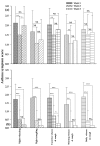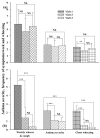Improvement in symptoms and pulmonary function of asthmatic patients due to their treatment according to the Global Strategy for Asthma Management (GINA)
- PMID: 19102753
- PMCID: PMC2631486
- DOI: 10.1186/1471-2466-8-26
Improvement in symptoms and pulmonary function of asthmatic patients due to their treatment according to the Global Strategy for Asthma Management (GINA)
Abstract
Background: Global Initiative Strategy for Asthma Management (GINA) is poorly applied in undeveloped and developing countries. The current study examined the effects of applying GINA guidelines on treatment efficacy in asthmatic patients in Iran.
Methods: Twenty four asthmatic patients (usual care group) were treated as usual and 26 patients (intervention group) according to the GINA for 2 months. Asthma symptom score, asthma severity, frequency of symptoms/week and wheezing were recorded at the beginning (first visit), one month after treatment (second visit), and at the end of the study (third visit). Pulmonary function tests (PFTs) were performed by spirometry, and the patients' use of asthma drugs and their symptoms were evaluated, at each visit.
Results: Asthma symptoms, frequency of symptoms/week, chest wheezing, and PFT values were significantly improved in the intervention group at the second and third visits compared to first visit (p < 0.001 for all measures). In addition, exercise induced cough and wheeze were significant improved in the third visit compared to the second visit in this group (p < 0.01 for both measures). In the second and third visits all symptoms were significantly lower, and PFT values higher, in the intervention group compared to the usual care group (p < 0.005 to p < 0.001). In the usual care group, there were only small improvements in some parameters in just the second visit (p < 0.01 for all measures). The use of asthma drugs was unchanged in the usual care group and significantly reduced in the intervention group (p < 0.01) by the end of the study.
Conclusion: Adoption of GINA guidelines improves asthma symptoms and pulmonary function in asthmatic patients in Iran.
Figures



Similar articles
-
The possible prophylactic effect of Nigella sativa seed extract in asthmatic patients.Fundam Clin Pharmacol. 2007 Oct;21(5):559-66. doi: 10.1111/j.1472-8206.2007.00509.x. Fundam Clin Pharmacol. 2007. PMID: 17868210 Clinical Trial.
-
Efficacy of zafirlukast in the treatment of patients with bronchial asthma.J Microbiol Immunol Infect. 2001 Mar;34(1):63-70. J Microbiol Immunol Infect. 2001. PMID: 11321130 Clinical Trial.
-
Is It Time to Leave Behind the Concept of Asthma Control and Severity Steps?J Asthma. 2021 Mar;58(3):281-283. doi: 10.1080/02770903.2019.1690659. Epub 2019 Nov 14. J Asthma. 2021. PMID: 31724457
-
Asthma and other wheezing disorders of childhood.Clin Evid. 2003 Jun;(9):287-317. Clin Evid. 2003. Update in: Clin Evid. 2004 Jun;(11):328-59. PMID: 15366138 Updated. Review. No abstract available.
-
Managing adult asthma: The 2019 GINA guidelines.Cleve Clin J Med. 2020 Aug 31;87(9):569-575. doi: 10.3949/ccjm.87a.19136. Cleve Clin J Med. 2020. PMID: 32868307 Review.
Cited by
-
A systematic review of the implementation and impact of asthma protocols.BMC Med Inform Decis Mak. 2014 Sep 9;14:82. doi: 10.1186/1472-6947-14-82. BMC Med Inform Decis Mak. 2014. PMID: 25204381 Free PMC article.
-
Lung Function and Asthma Clinical Control in N-ERD Patients, Three-Year Follow-Up in the Context of Real-World Evidence.J Asthma Allergy. 2023 Sep 6;16:937-950. doi: 10.2147/JAA.S418802. eCollection 2023. J Asthma Allergy. 2023. PMID: 37700875 Free PMC article.
-
Implementation of GINA guidelines in Ho Chi Minh City: a model for Viet Nam.Public Health Action. 2012 Dec 21;2(4):181-5. doi: 10.5588/pha.12.0035. Epub 2012 Nov 15. Public Health Action. 2012. PMID: 26392981 Free PMC article.
References
-
- Boskabady MH, Karimian M. Prevalence of asthma among guidance school students (aged 11–16 years) in the city of Mashhad (north east of Iran) Arch Iran Med. 2000;3:165–169.
-
- National Institutes of Health . NHBLI workshop report. Bethesda, MD, January, Publication No. 02-3659; 2002. Global strategy for asthma management and prevention.
Publication types
MeSH terms
Substances
LinkOut - more resources
Full Text Sources
Medical

